Literature Review on Air Pollution Reduction and Mitigation
VerifiedAdded on 2023/06/12
|9
|2677
|370
Literature Review
AI Summary
This literature review examines strategies for mitigating air pollution from both inland and ocean transportation sources. It highlights the impact of pollutants like CO, Sulphur oxides, and particulate matter on global warming and human health, referencing the Paris Agreement and the role of the International Maritime Organization (IMO) in regulating shipping emissions. The review discusses the effects of air pollution on coastal communities, respiratory health, and the environment, emphasizing the need for eco-friendly fuels and advanced technologies in the maritime industry. It also explores mitigation strategies such as forest restoration, changes in diesel engine technology, and the implementation of environmental management policies, while addressing the challenges of indoor air pollution and the importance of land planning and renewable energy sources. The literature underscores the need for collaborative efforts between governments, industries, and individuals to reduce air pollution and protect the environment.
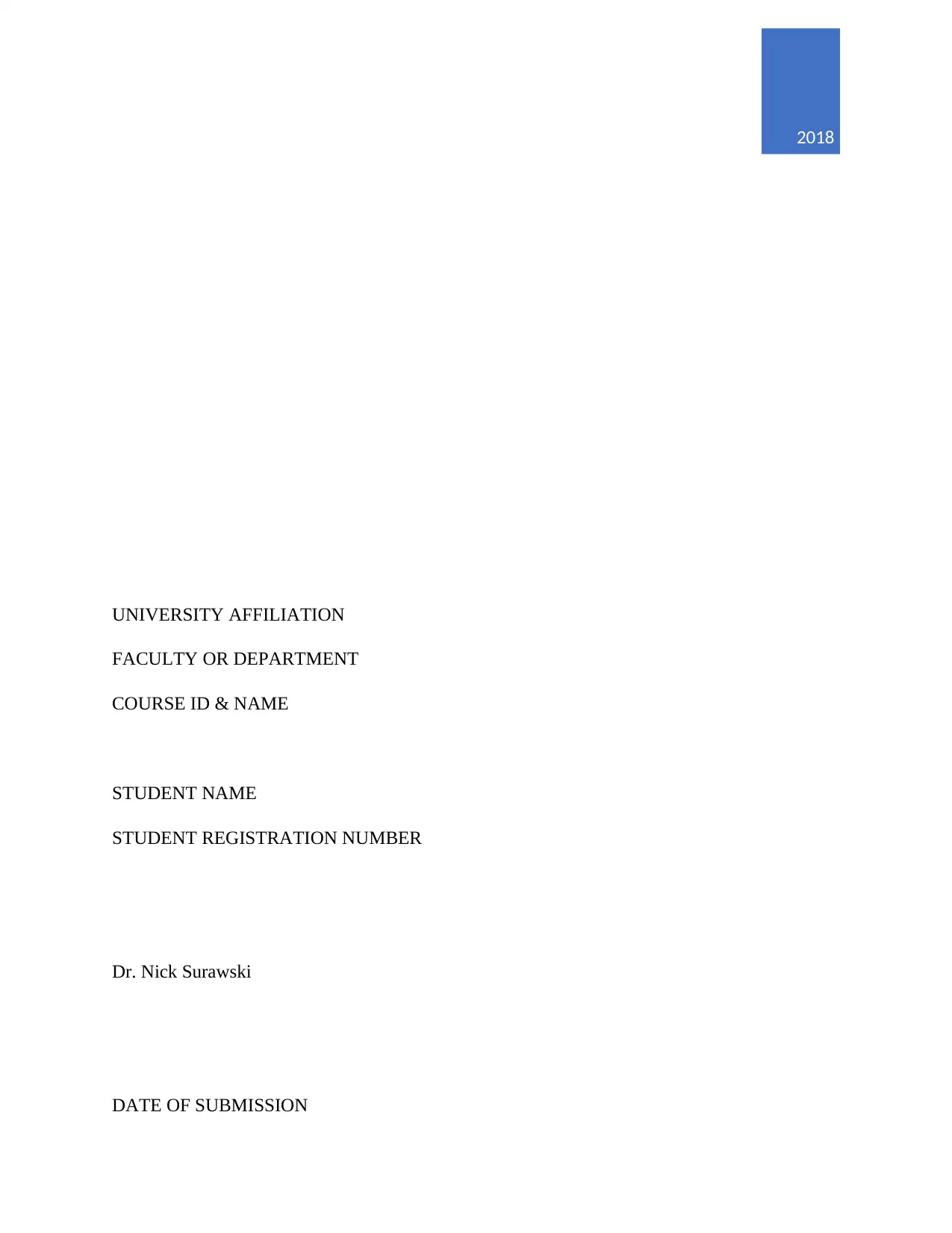
UNIVERSITY AFFILIATION
FACULTY OR DEPARTMENT
COURSE ID & NAME
STUDENT NAME
STUDENT REGISTRATION NUMBER
Dr. Nick Surawski
DATE OF SUBMISSION
2018
FACULTY OR DEPARTMENT
COURSE ID & NAME
STUDENT NAME
STUDENT REGISTRATION NUMBER
Dr. Nick Surawski
DATE OF SUBMISSION
2018
Paraphrase This Document
Need a fresh take? Get an instant paraphrase of this document with our AI Paraphraser
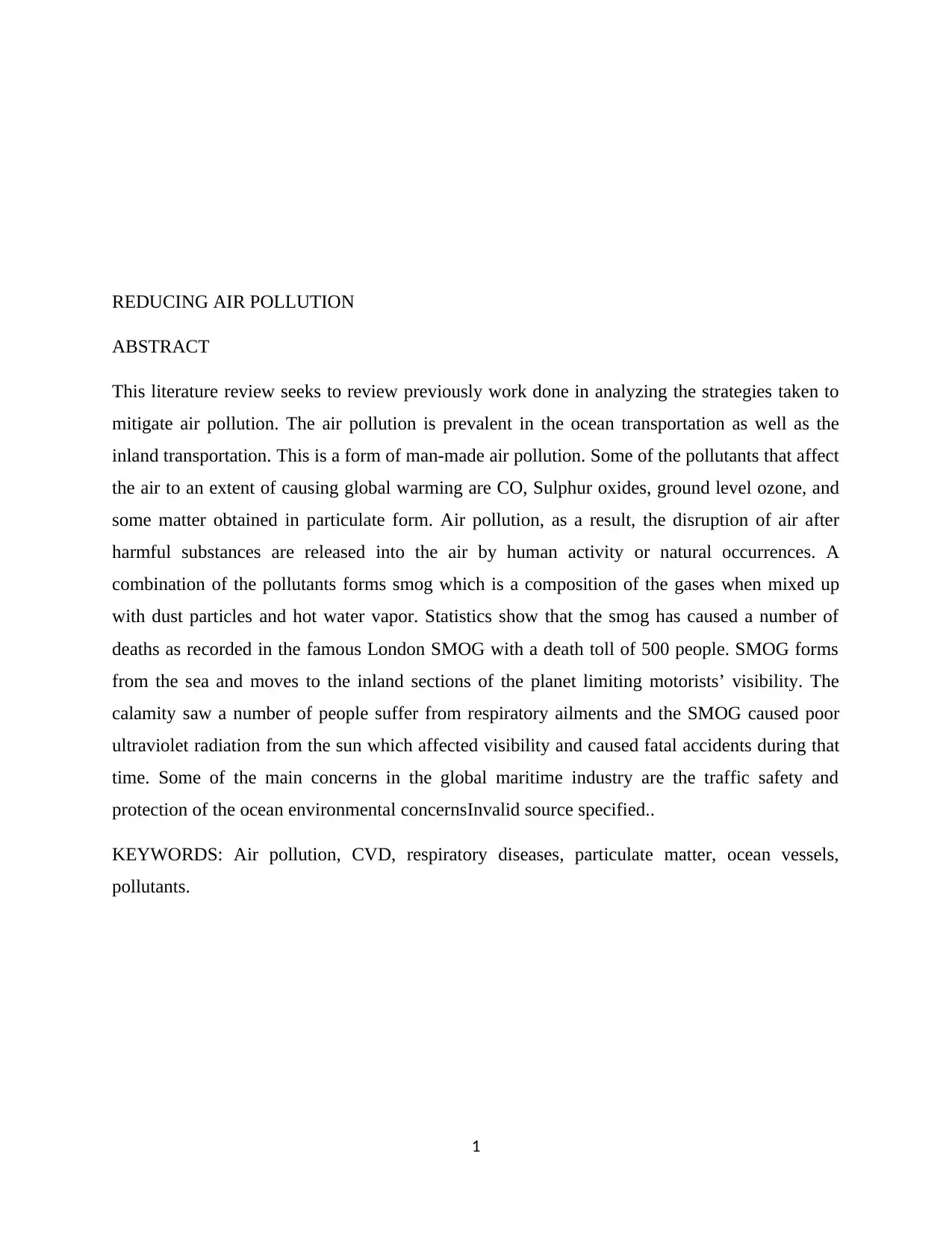
REDUCING AIR POLLUTION
ABSTRACT
This literature review seeks to review previously work done in analyzing the strategies taken to
mitigate air pollution. The air pollution is prevalent in the ocean transportation as well as the
inland transportation. This is a form of man-made air pollution. Some of the pollutants that affect
the air to an extent of causing global warming are CO, Sulphur oxides, ground level ozone, and
some matter obtained in particulate form. Air pollution, as a result, the disruption of air after
harmful substances are released into the air by human activity or natural occurrences. A
combination of the pollutants forms smog which is a composition of the gases when mixed up
with dust particles and hot water vapor. Statistics show that the smog has caused a number of
deaths as recorded in the famous London SMOG with a death toll of 500 people. SMOG forms
from the sea and moves to the inland sections of the planet limiting motorists’ visibility. The
calamity saw a number of people suffer from respiratory ailments and the SMOG caused poor
ultraviolet radiation from the sun which affected visibility and caused fatal accidents during that
time. Some of the main concerns in the global maritime industry are the traffic safety and
protection of the ocean environmental concernsInvalid source specified..
KEYWORDS: Air pollution, CVD, respiratory diseases, particulate matter, ocean vessels,
pollutants.
1
ABSTRACT
This literature review seeks to review previously work done in analyzing the strategies taken to
mitigate air pollution. The air pollution is prevalent in the ocean transportation as well as the
inland transportation. This is a form of man-made air pollution. Some of the pollutants that affect
the air to an extent of causing global warming are CO, Sulphur oxides, ground level ozone, and
some matter obtained in particulate form. Air pollution, as a result, the disruption of air after
harmful substances are released into the air by human activity or natural occurrences. A
combination of the pollutants forms smog which is a composition of the gases when mixed up
with dust particles and hot water vapor. Statistics show that the smog has caused a number of
deaths as recorded in the famous London SMOG with a death toll of 500 people. SMOG forms
from the sea and moves to the inland sections of the planet limiting motorists’ visibility. The
calamity saw a number of people suffer from respiratory ailments and the SMOG caused poor
ultraviolet radiation from the sun which affected visibility and caused fatal accidents during that
time. Some of the main concerns in the global maritime industry are the traffic safety and
protection of the ocean environmental concernsInvalid source specified..
KEYWORDS: Air pollution, CVD, respiratory diseases, particulate matter, ocean vessels,
pollutants.
1
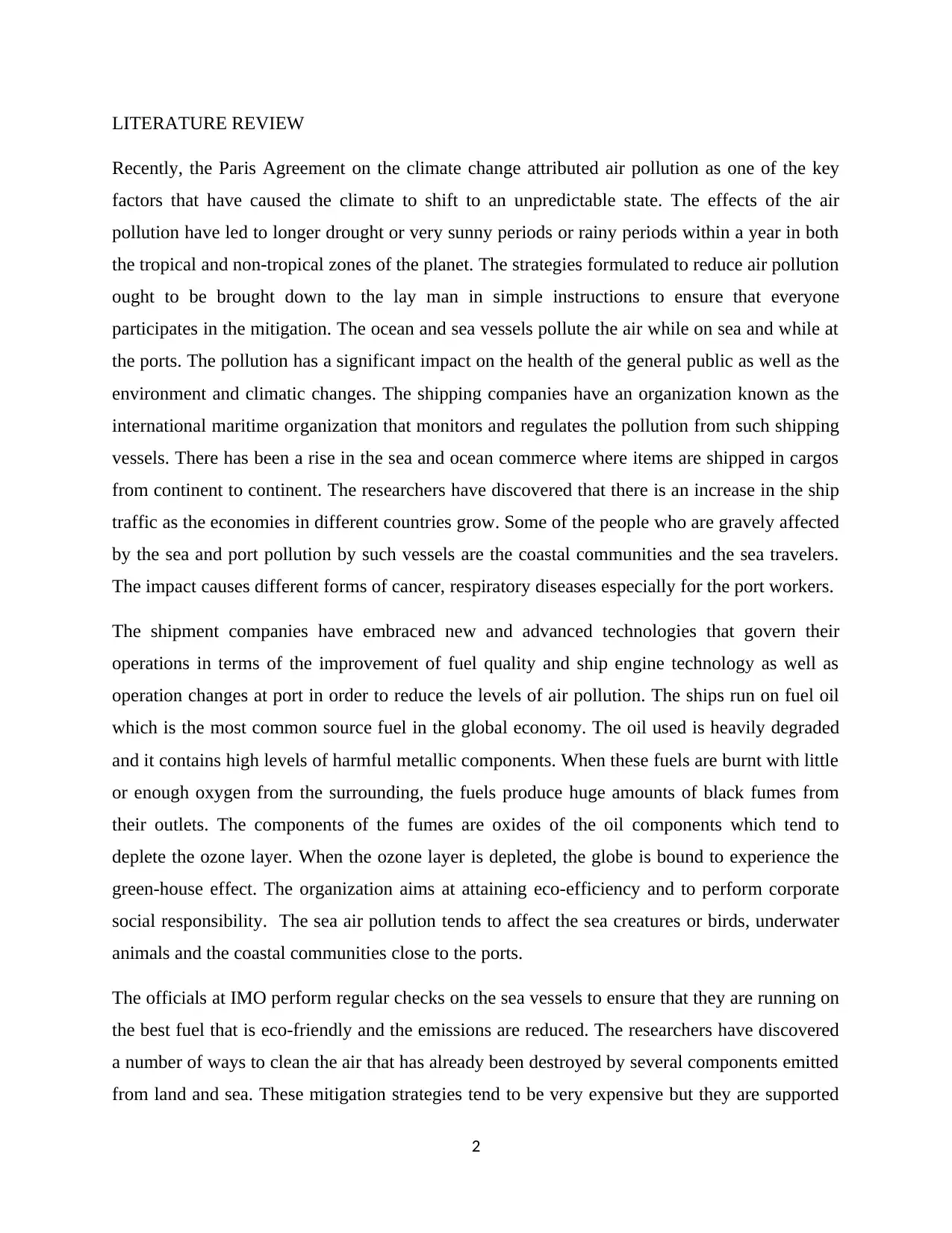
LITERATURE REVIEW
Recently, the Paris Agreement on the climate change attributed air pollution as one of the key
factors that have caused the climate to shift to an unpredictable state. The effects of the air
pollution have led to longer drought or very sunny periods or rainy periods within a year in both
the tropical and non-tropical zones of the planet. The strategies formulated to reduce air pollution
ought to be brought down to the lay man in simple instructions to ensure that everyone
participates in the mitigation. The ocean and sea vessels pollute the air while on sea and while at
the ports. The pollution has a significant impact on the health of the general public as well as the
environment and climatic changes. The shipping companies have an organization known as the
international maritime organization that monitors and regulates the pollution from such shipping
vessels. There has been a rise in the sea and ocean commerce where items are shipped in cargos
from continent to continent. The researchers have discovered that there is an increase in the ship
traffic as the economies in different countries grow. Some of the people who are gravely affected
by the sea and port pollution by such vessels are the coastal communities and the sea travelers.
The impact causes different forms of cancer, respiratory diseases especially for the port workers.
The shipment companies have embraced new and advanced technologies that govern their
operations in terms of the improvement of fuel quality and ship engine technology as well as
operation changes at port in order to reduce the levels of air pollution. The ships run on fuel oil
which is the most common source fuel in the global economy. The oil used is heavily degraded
and it contains high levels of harmful metallic components. When these fuels are burnt with little
or enough oxygen from the surrounding, the fuels produce huge amounts of black fumes from
their outlets. The components of the fumes are oxides of the oil components which tend to
deplete the ozone layer. When the ozone layer is depleted, the globe is bound to experience the
green-house effect. The organization aims at attaining eco-efficiency and to perform corporate
social responsibility. The sea air pollution tends to affect the sea creatures or birds, underwater
animals and the coastal communities close to the ports.
The officials at IMO perform regular checks on the sea vessels to ensure that they are running on
the best fuel that is eco-friendly and the emissions are reduced. The researchers have discovered
a number of ways to clean the air that has already been destroyed by several components emitted
from land and sea. These mitigation strategies tend to be very expensive but they are supported
2
Recently, the Paris Agreement on the climate change attributed air pollution as one of the key
factors that have caused the climate to shift to an unpredictable state. The effects of the air
pollution have led to longer drought or very sunny periods or rainy periods within a year in both
the tropical and non-tropical zones of the planet. The strategies formulated to reduce air pollution
ought to be brought down to the lay man in simple instructions to ensure that everyone
participates in the mitigation. The ocean and sea vessels pollute the air while on sea and while at
the ports. The pollution has a significant impact on the health of the general public as well as the
environment and climatic changes. The shipping companies have an organization known as the
international maritime organization that monitors and regulates the pollution from such shipping
vessels. There has been a rise in the sea and ocean commerce where items are shipped in cargos
from continent to continent. The researchers have discovered that there is an increase in the ship
traffic as the economies in different countries grow. Some of the people who are gravely affected
by the sea and port pollution by such vessels are the coastal communities and the sea travelers.
The impact causes different forms of cancer, respiratory diseases especially for the port workers.
The shipment companies have embraced new and advanced technologies that govern their
operations in terms of the improvement of fuel quality and ship engine technology as well as
operation changes at port in order to reduce the levels of air pollution. The ships run on fuel oil
which is the most common source fuel in the global economy. The oil used is heavily degraded
and it contains high levels of harmful metallic components. When these fuels are burnt with little
or enough oxygen from the surrounding, the fuels produce huge amounts of black fumes from
their outlets. The components of the fumes are oxides of the oil components which tend to
deplete the ozone layer. When the ozone layer is depleted, the globe is bound to experience the
green-house effect. The organization aims at attaining eco-efficiency and to perform corporate
social responsibility. The sea air pollution tends to affect the sea creatures or birds, underwater
animals and the coastal communities close to the ports.
The officials at IMO perform regular checks on the sea vessels to ensure that they are running on
the best fuel that is eco-friendly and the emissions are reduced. The researchers have discovered
a number of ways to clean the air that has already been destroyed by several components emitted
from land and sea. These mitigation strategies tend to be very expensive but they are supported
2
⊘ This is a preview!⊘
Do you want full access?
Subscribe today to unlock all pages.

Trusted by 1+ million students worldwide
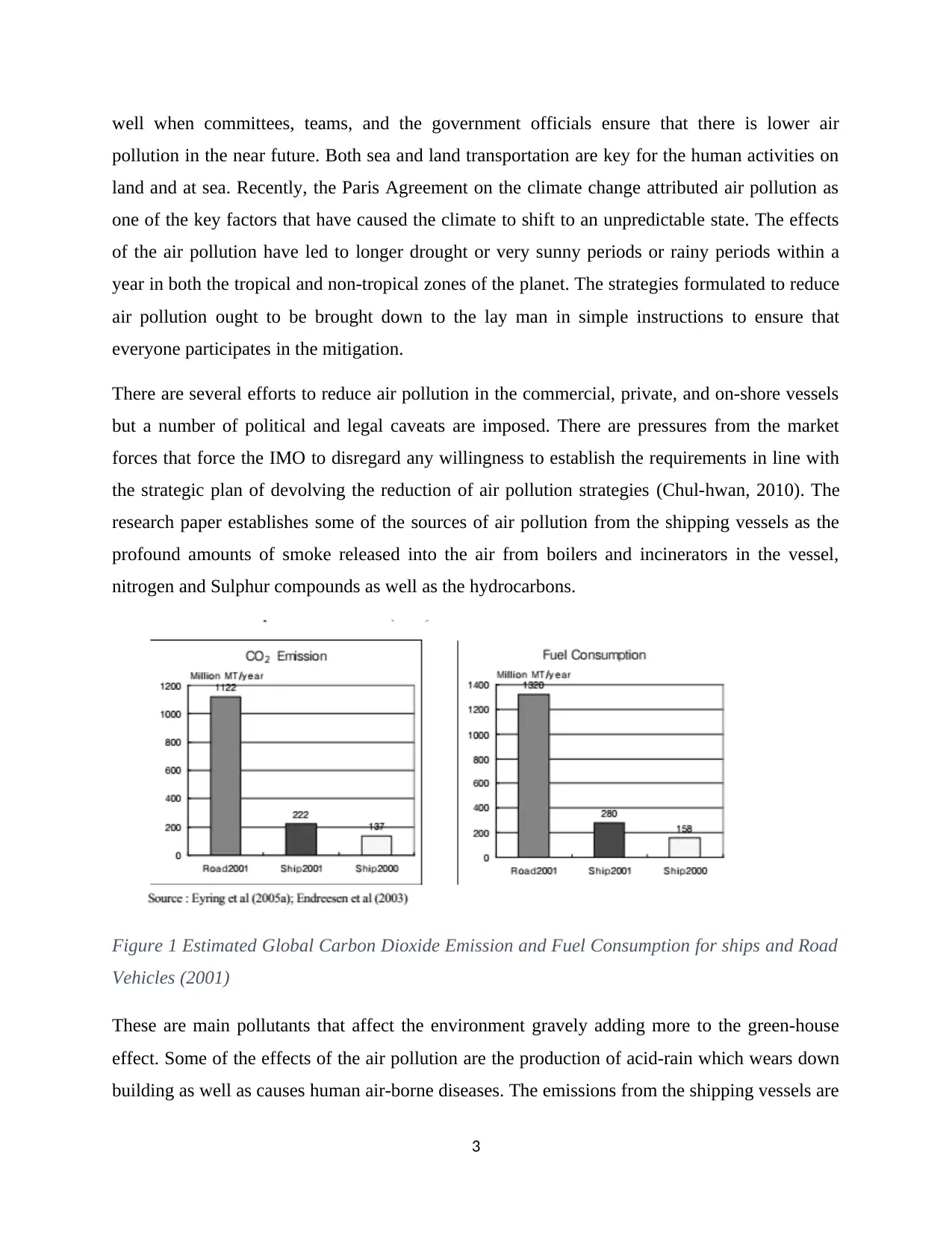
well when committees, teams, and the government officials ensure that there is lower air
pollution in the near future. Both sea and land transportation are key for the human activities on
land and at sea. Recently, the Paris Agreement on the climate change attributed air pollution as
one of the key factors that have caused the climate to shift to an unpredictable state. The effects
of the air pollution have led to longer drought or very sunny periods or rainy periods within a
year in both the tropical and non-tropical zones of the planet. The strategies formulated to reduce
air pollution ought to be brought down to the lay man in simple instructions to ensure that
everyone participates in the mitigation.
There are several efforts to reduce air pollution in the commercial, private, and on-shore vessels
but a number of political and legal caveats are imposed. There are pressures from the market
forces that force the IMO to disregard any willingness to establish the requirements in line with
the strategic plan of devolving the reduction of air pollution strategies (Chul-hwan, 2010). The
research paper establishes some of the sources of air pollution from the shipping vessels as the
profound amounts of smoke released into the air from boilers and incinerators in the vessel,
nitrogen and Sulphur compounds as well as the hydrocarbons.
Figure 1 Estimated Global Carbon Dioxide Emission and Fuel Consumption for ships and Road
Vehicles (2001)
These are main pollutants that affect the environment gravely adding more to the green-house
effect. Some of the effects of the air pollution are the production of acid-rain which wears down
building as well as causes human air-borne diseases. The emissions from the shipping vessels are
3
pollution in the near future. Both sea and land transportation are key for the human activities on
land and at sea. Recently, the Paris Agreement on the climate change attributed air pollution as
one of the key factors that have caused the climate to shift to an unpredictable state. The effects
of the air pollution have led to longer drought or very sunny periods or rainy periods within a
year in both the tropical and non-tropical zones of the planet. The strategies formulated to reduce
air pollution ought to be brought down to the lay man in simple instructions to ensure that
everyone participates in the mitigation.
There are several efforts to reduce air pollution in the commercial, private, and on-shore vessels
but a number of political and legal caveats are imposed. There are pressures from the market
forces that force the IMO to disregard any willingness to establish the requirements in line with
the strategic plan of devolving the reduction of air pollution strategies (Chul-hwan, 2010). The
research paper establishes some of the sources of air pollution from the shipping vessels as the
profound amounts of smoke released into the air from boilers and incinerators in the vessel,
nitrogen and Sulphur compounds as well as the hydrocarbons.
Figure 1 Estimated Global Carbon Dioxide Emission and Fuel Consumption for ships and Road
Vehicles (2001)
These are main pollutants that affect the environment gravely adding more to the green-house
effect. Some of the effects of the air pollution are the production of acid-rain which wears down
building as well as causes human air-borne diseases. The emissions from the shipping vessels are
3
Paraphrase This Document
Need a fresh take? Get an instant paraphrase of this document with our AI Paraphraser
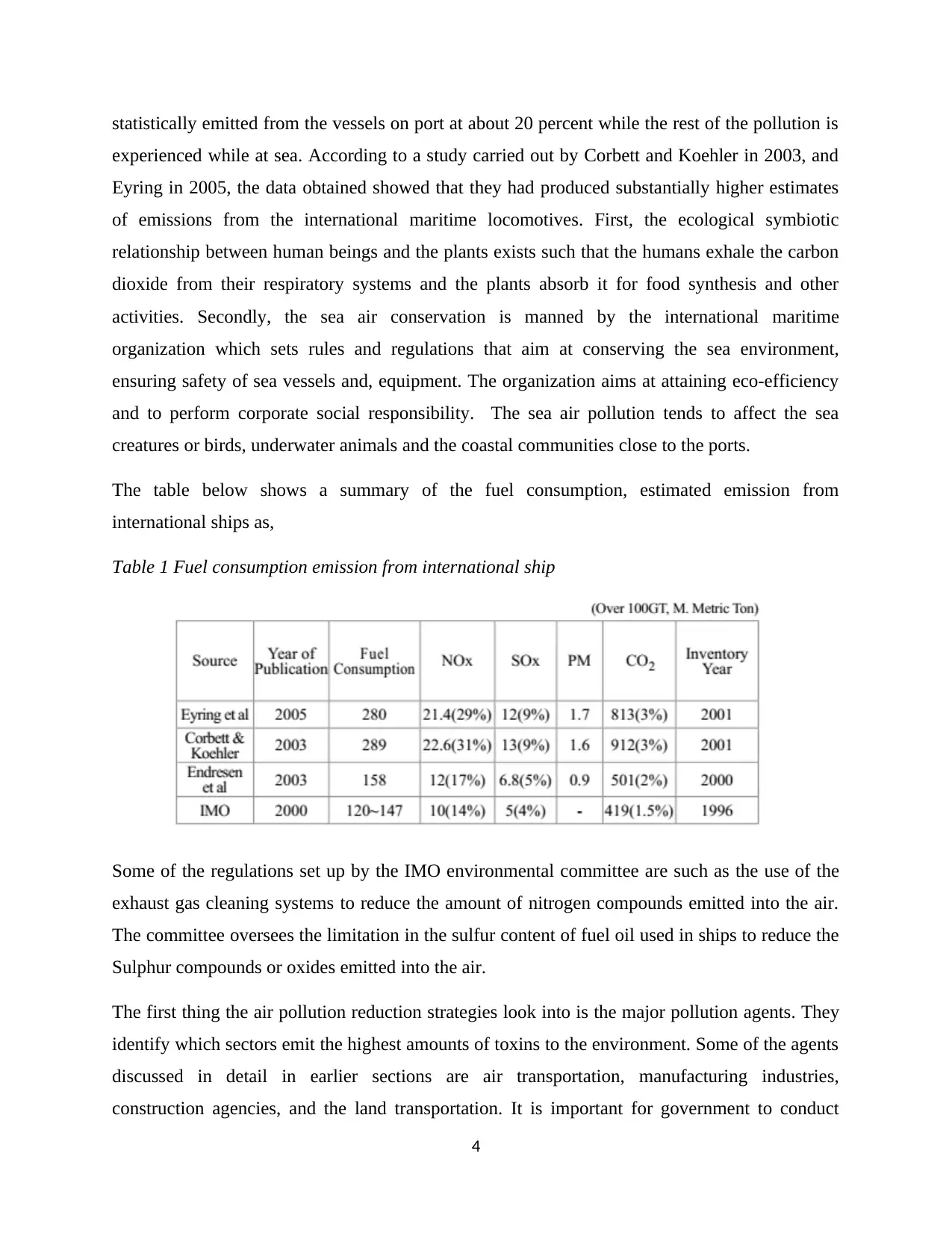
statistically emitted from the vessels on port at about 20 percent while the rest of the pollution is
experienced while at sea. According to a study carried out by Corbett and Koehler in 2003, and
Eyring in 2005, the data obtained showed that they had produced substantially higher estimates
of emissions from the international maritime locomotives. First, the ecological symbiotic
relationship between human beings and the plants exists such that the humans exhale the carbon
dioxide from their respiratory systems and the plants absorb it for food synthesis and other
activities. Secondly, the sea air conservation is manned by the international maritime
organization which sets rules and regulations that aim at conserving the sea environment,
ensuring safety of sea vessels and, equipment. The organization aims at attaining eco-efficiency
and to perform corporate social responsibility. The sea air pollution tends to affect the sea
creatures or birds, underwater animals and the coastal communities close to the ports.
The table below shows a summary of the fuel consumption, estimated emission from
international ships as,
Table 1 Fuel consumption emission from international ship
Some of the regulations set up by the IMO environmental committee are such as the use of the
exhaust gas cleaning systems to reduce the amount of nitrogen compounds emitted into the air.
The committee oversees the limitation in the sulfur content of fuel oil used in ships to reduce the
Sulphur compounds or oxides emitted into the air.
The first thing the air pollution reduction strategies look into is the major pollution agents. They
identify which sectors emit the highest amounts of toxins to the environment. Some of the agents
discussed in detail in earlier sections are air transportation, manufacturing industries,
construction agencies, and the land transportation. It is important for government to conduct
4
experienced while at sea. According to a study carried out by Corbett and Koehler in 2003, and
Eyring in 2005, the data obtained showed that they had produced substantially higher estimates
of emissions from the international maritime locomotives. First, the ecological symbiotic
relationship between human beings and the plants exists such that the humans exhale the carbon
dioxide from their respiratory systems and the plants absorb it for food synthesis and other
activities. Secondly, the sea air conservation is manned by the international maritime
organization which sets rules and regulations that aim at conserving the sea environment,
ensuring safety of sea vessels and, equipment. The organization aims at attaining eco-efficiency
and to perform corporate social responsibility. The sea air pollution tends to affect the sea
creatures or birds, underwater animals and the coastal communities close to the ports.
The table below shows a summary of the fuel consumption, estimated emission from
international ships as,
Table 1 Fuel consumption emission from international ship
Some of the regulations set up by the IMO environmental committee are such as the use of the
exhaust gas cleaning systems to reduce the amount of nitrogen compounds emitted into the air.
The committee oversees the limitation in the sulfur content of fuel oil used in ships to reduce the
Sulphur compounds or oxides emitted into the air.
The first thing the air pollution reduction strategies look into is the major pollution agents. They
identify which sectors emit the highest amounts of toxins to the environment. Some of the agents
discussed in detail in earlier sections are air transportation, manufacturing industries,
construction agencies, and the land transportation. It is important for government to conduct
4
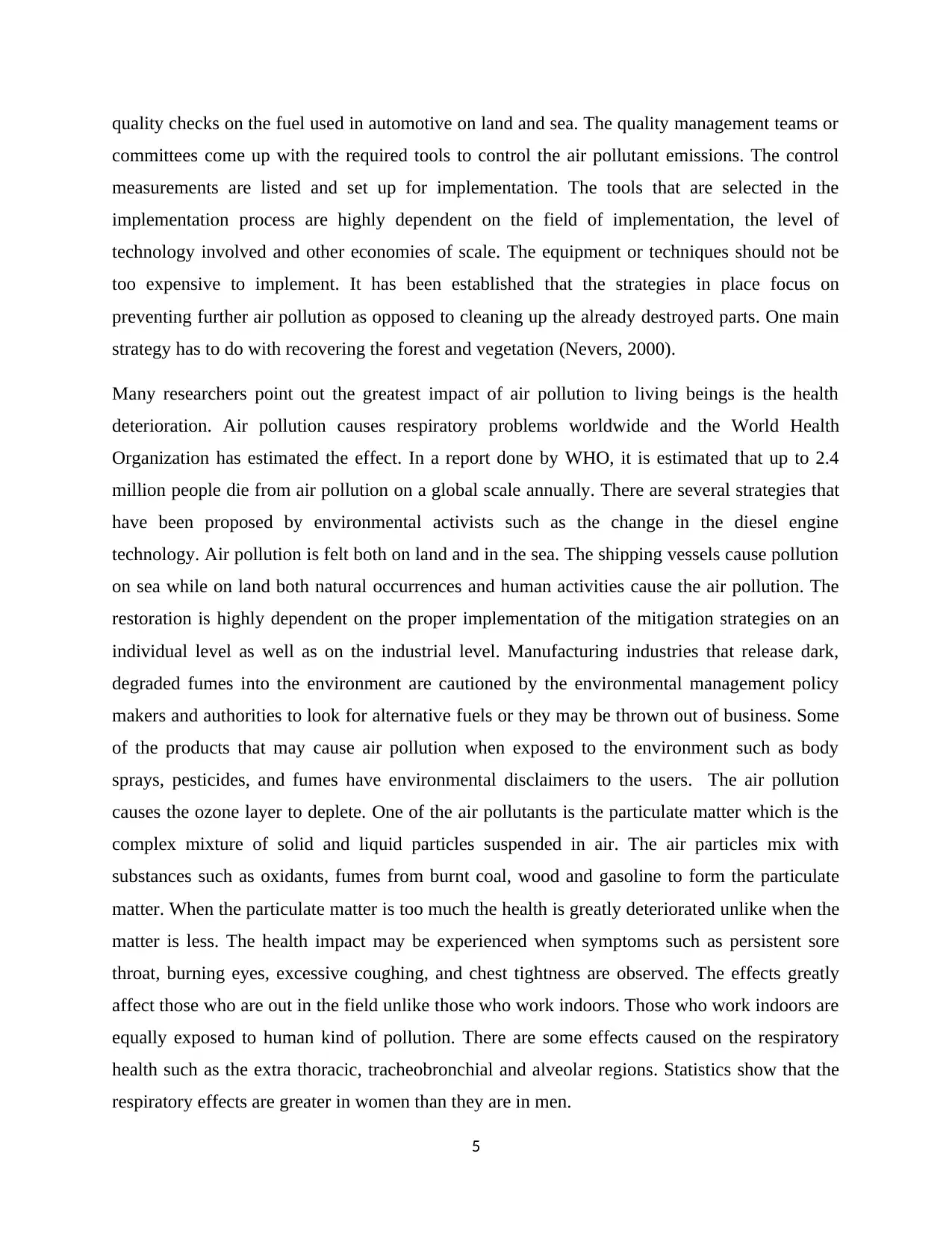
quality checks on the fuel used in automotive on land and sea. The quality management teams or
committees come up with the required tools to control the air pollutant emissions. The control
measurements are listed and set up for implementation. The tools that are selected in the
implementation process are highly dependent on the field of implementation, the level of
technology involved and other economies of scale. The equipment or techniques should not be
too expensive to implement. It has been established that the strategies in place focus on
preventing further air pollution as opposed to cleaning up the already destroyed parts. One main
strategy has to do with recovering the forest and vegetation (Nevers, 2000).
Many researchers point out the greatest impact of air pollution to living beings is the health
deterioration. Air pollution causes respiratory problems worldwide and the World Health
Organization has estimated the effect. In a report done by WHO, it is estimated that up to 2.4
million people die from air pollution on a global scale annually. There are several strategies that
have been proposed by environmental activists such as the change in the diesel engine
technology. Air pollution is felt both on land and in the sea. The shipping vessels cause pollution
on sea while on land both natural occurrences and human activities cause the air pollution. The
restoration is highly dependent on the proper implementation of the mitigation strategies on an
individual level as well as on the industrial level. Manufacturing industries that release dark,
degraded fumes into the environment are cautioned by the environmental management policy
makers and authorities to look for alternative fuels or they may be thrown out of business. Some
of the products that may cause air pollution when exposed to the environment such as body
sprays, pesticides, and fumes have environmental disclaimers to the users. The air pollution
causes the ozone layer to deplete. One of the air pollutants is the particulate matter which is the
complex mixture of solid and liquid particles suspended in air. The air particles mix with
substances such as oxidants, fumes from burnt coal, wood and gasoline to form the particulate
matter. When the particulate matter is too much the health is greatly deteriorated unlike when the
matter is less. The health impact may be experienced when symptoms such as persistent sore
throat, burning eyes, excessive coughing, and chest tightness are observed. The effects greatly
affect those who are out in the field unlike those who work indoors. Those who work indoors are
equally exposed to human kind of pollution. There are some effects caused on the respiratory
health such as the extra thoracic, tracheobronchial and alveolar regions. Statistics show that the
respiratory effects are greater in women than they are in men.
5
committees come up with the required tools to control the air pollutant emissions. The control
measurements are listed and set up for implementation. The tools that are selected in the
implementation process are highly dependent on the field of implementation, the level of
technology involved and other economies of scale. The equipment or techniques should not be
too expensive to implement. It has been established that the strategies in place focus on
preventing further air pollution as opposed to cleaning up the already destroyed parts. One main
strategy has to do with recovering the forest and vegetation (Nevers, 2000).
Many researchers point out the greatest impact of air pollution to living beings is the health
deterioration. Air pollution causes respiratory problems worldwide and the World Health
Organization has estimated the effect. In a report done by WHO, it is estimated that up to 2.4
million people die from air pollution on a global scale annually. There are several strategies that
have been proposed by environmental activists such as the change in the diesel engine
technology. Air pollution is felt both on land and in the sea. The shipping vessels cause pollution
on sea while on land both natural occurrences and human activities cause the air pollution. The
restoration is highly dependent on the proper implementation of the mitigation strategies on an
individual level as well as on the industrial level. Manufacturing industries that release dark,
degraded fumes into the environment are cautioned by the environmental management policy
makers and authorities to look for alternative fuels or they may be thrown out of business. Some
of the products that may cause air pollution when exposed to the environment such as body
sprays, pesticides, and fumes have environmental disclaimers to the users. The air pollution
causes the ozone layer to deplete. One of the air pollutants is the particulate matter which is the
complex mixture of solid and liquid particles suspended in air. The air particles mix with
substances such as oxidants, fumes from burnt coal, wood and gasoline to form the particulate
matter. When the particulate matter is too much the health is greatly deteriorated unlike when the
matter is less. The health impact may be experienced when symptoms such as persistent sore
throat, burning eyes, excessive coughing, and chest tightness are observed. The effects greatly
affect those who are out in the field unlike those who work indoors. Those who work indoors are
equally exposed to human kind of pollution. There are some effects caused on the respiratory
health such as the extra thoracic, tracheobronchial and alveolar regions. Statistics show that the
respiratory effects are greater in women than they are in men.
5
⊘ This is a preview!⊘
Do you want full access?
Subscribe today to unlock all pages.

Trusted by 1+ million students worldwide
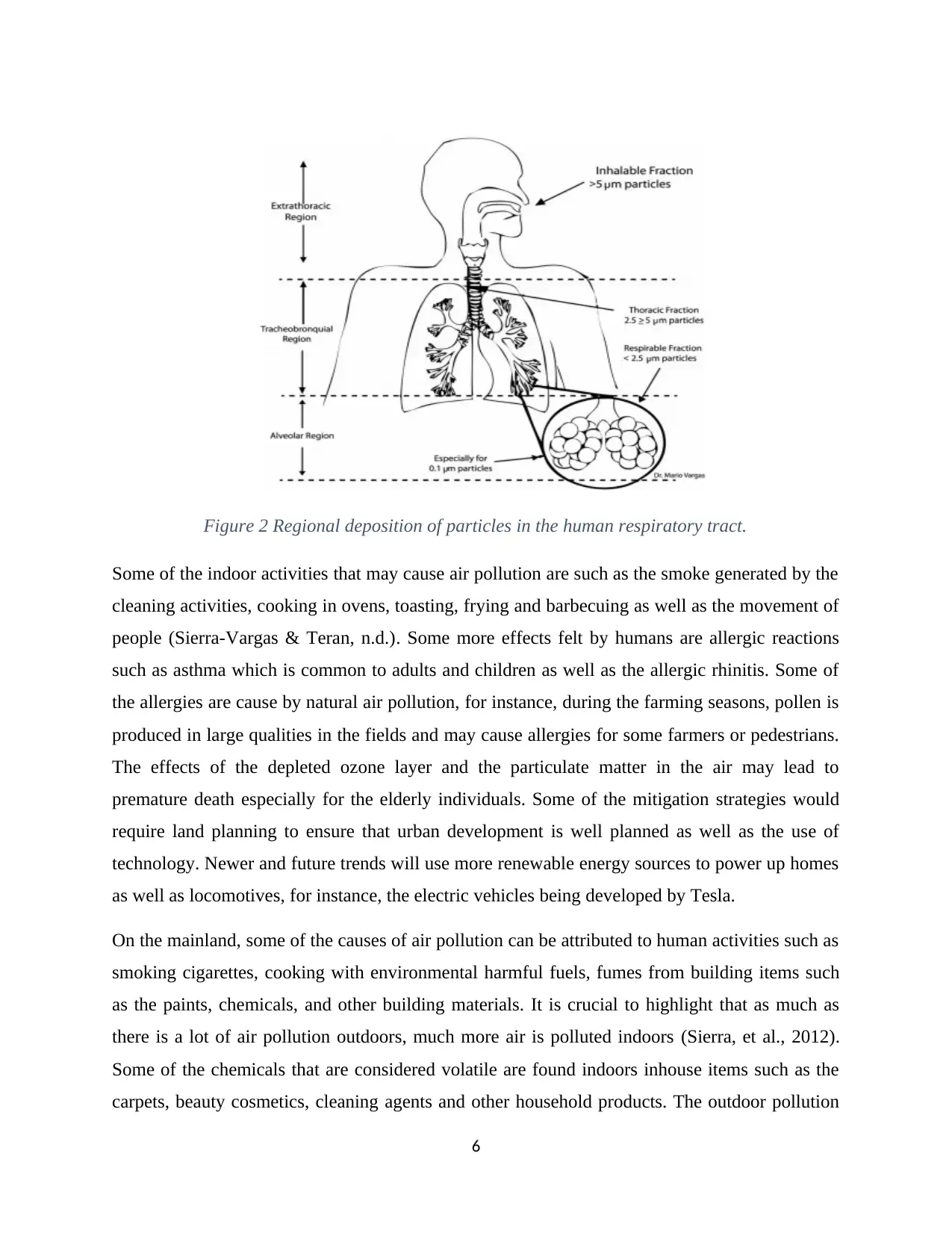
Figure 2 Regional deposition of particles in the human respiratory tract.
Some of the indoor activities that may cause air pollution are such as the smoke generated by the
cleaning activities, cooking in ovens, toasting, frying and barbecuing as well as the movement of
people (Sierra-Vargas & Teran, n.d.). Some more effects felt by humans are allergic reactions
such as asthma which is common to adults and children as well as the allergic rhinitis. Some of
the allergies are cause by natural air pollution, for instance, during the farming seasons, pollen is
produced in large qualities in the fields and may cause allergies for some farmers or pedestrians.
The effects of the depleted ozone layer and the particulate matter in the air may lead to
premature death especially for the elderly individuals. Some of the mitigation strategies would
require land planning to ensure that urban development is well planned as well as the use of
technology. Newer and future trends will use more renewable energy sources to power up homes
as well as locomotives, for instance, the electric vehicles being developed by Tesla.
On the mainland, some of the causes of air pollution can be attributed to human activities such as
smoking cigarettes, cooking with environmental harmful fuels, fumes from building items such
as the paints, chemicals, and other building materials. It is crucial to highlight that as much as
there is a lot of air pollution outdoors, much more air is polluted indoors (Sierra, et al., 2012).
Some of the chemicals that are considered volatile are found indoors inhouse items such as the
carpets, beauty cosmetics, cleaning agents and other household products. The outdoor pollution
6
Some of the indoor activities that may cause air pollution are such as the smoke generated by the
cleaning activities, cooking in ovens, toasting, frying and barbecuing as well as the movement of
people (Sierra-Vargas & Teran, n.d.). Some more effects felt by humans are allergic reactions
such as asthma which is common to adults and children as well as the allergic rhinitis. Some of
the allergies are cause by natural air pollution, for instance, during the farming seasons, pollen is
produced in large qualities in the fields and may cause allergies for some farmers or pedestrians.
The effects of the depleted ozone layer and the particulate matter in the air may lead to
premature death especially for the elderly individuals. Some of the mitigation strategies would
require land planning to ensure that urban development is well planned as well as the use of
technology. Newer and future trends will use more renewable energy sources to power up homes
as well as locomotives, for instance, the electric vehicles being developed by Tesla.
On the mainland, some of the causes of air pollution can be attributed to human activities such as
smoking cigarettes, cooking with environmental harmful fuels, fumes from building items such
as the paints, chemicals, and other building materials. It is crucial to highlight that as much as
there is a lot of air pollution outdoors, much more air is polluted indoors (Sierra, et al., 2012).
Some of the chemicals that are considered volatile are found indoors inhouse items such as the
carpets, beauty cosmetics, cleaning agents and other household products. The outdoor pollution
6
Paraphrase This Document
Need a fresh take? Get an instant paraphrase of this document with our AI Paraphraser
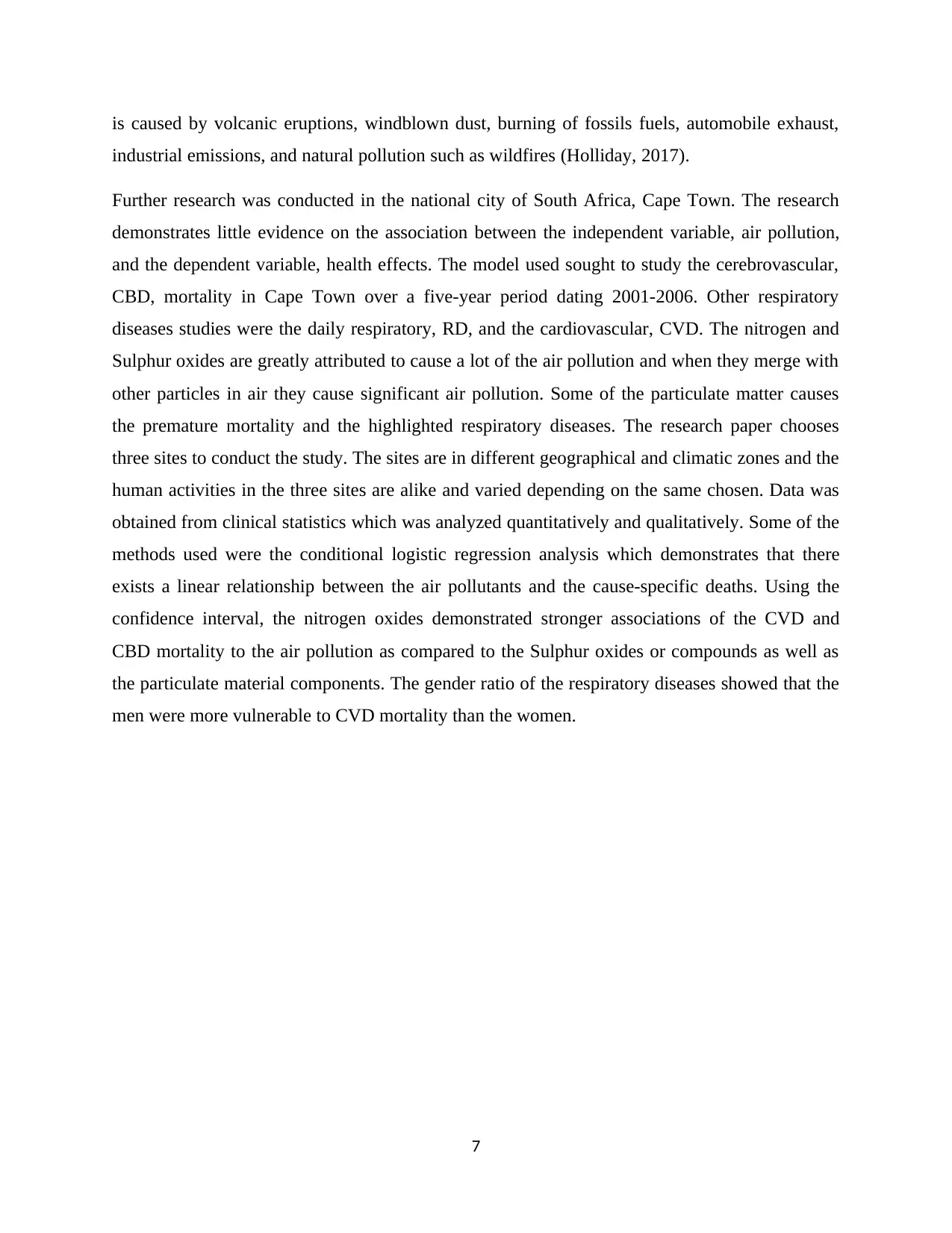
is caused by volcanic eruptions, windblown dust, burning of fossils fuels, automobile exhaust,
industrial emissions, and natural pollution such as wildfires (Holliday, 2017).
Further research was conducted in the national city of South Africa, Cape Town. The research
demonstrates little evidence on the association between the independent variable, air pollution,
and the dependent variable, health effects. The model used sought to study the cerebrovascular,
CBD, mortality in Cape Town over a five-year period dating 2001-2006. Other respiratory
diseases studies were the daily respiratory, RD, and the cardiovascular, CVD. The nitrogen and
Sulphur oxides are greatly attributed to cause a lot of the air pollution and when they merge with
other particles in air they cause significant air pollution. Some of the particulate matter causes
the premature mortality and the highlighted respiratory diseases. The research paper chooses
three sites to conduct the study. The sites are in different geographical and climatic zones and the
human activities in the three sites are alike and varied depending on the same chosen. Data was
obtained from clinical statistics which was analyzed quantitatively and qualitatively. Some of the
methods used were the conditional logistic regression analysis which demonstrates that there
exists a linear relationship between the air pollutants and the cause-specific deaths. Using the
confidence interval, the nitrogen oxides demonstrated stronger associations of the CVD and
CBD mortality to the air pollution as compared to the Sulphur oxides or compounds as well as
the particulate material components. The gender ratio of the respiratory diseases showed that the
men were more vulnerable to CVD mortality than the women.
7
industrial emissions, and natural pollution such as wildfires (Holliday, 2017).
Further research was conducted in the national city of South Africa, Cape Town. The research
demonstrates little evidence on the association between the independent variable, air pollution,
and the dependent variable, health effects. The model used sought to study the cerebrovascular,
CBD, mortality in Cape Town over a five-year period dating 2001-2006. Other respiratory
diseases studies were the daily respiratory, RD, and the cardiovascular, CVD. The nitrogen and
Sulphur oxides are greatly attributed to cause a lot of the air pollution and when they merge with
other particles in air they cause significant air pollution. Some of the particulate matter causes
the premature mortality and the highlighted respiratory diseases. The research paper chooses
three sites to conduct the study. The sites are in different geographical and climatic zones and the
human activities in the three sites are alike and varied depending on the same chosen. Data was
obtained from clinical statistics which was analyzed quantitatively and qualitatively. Some of the
methods used were the conditional logistic regression analysis which demonstrates that there
exists a linear relationship between the air pollutants and the cause-specific deaths. Using the
confidence interval, the nitrogen oxides demonstrated stronger associations of the CVD and
CBD mortality to the air pollution as compared to the Sulphur oxides or compounds as well as
the particulate material components. The gender ratio of the respiratory diseases showed that the
men were more vulnerable to CVD mortality than the women.
7
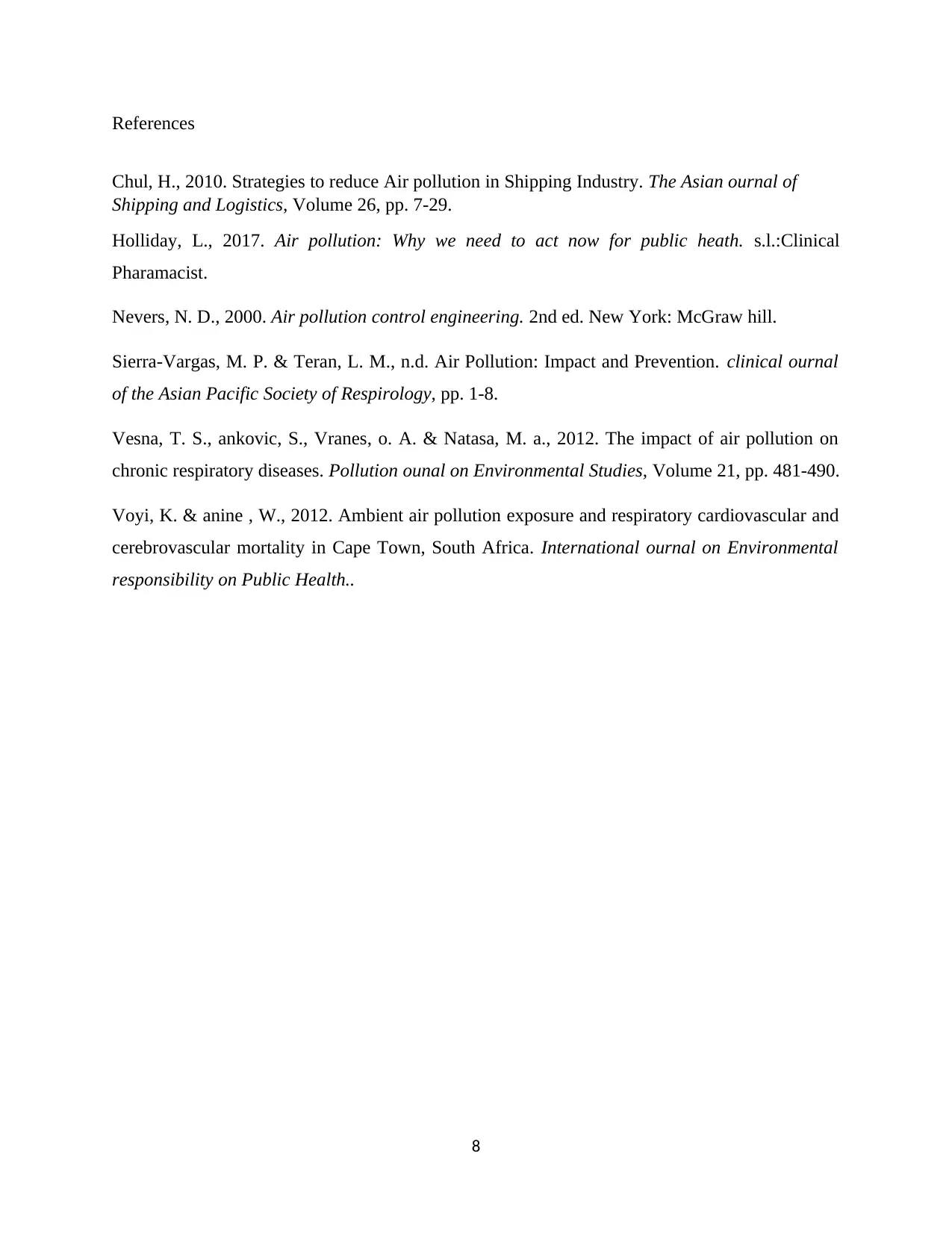
References
Chul, H., 2010. Strategies to reduce Air pollution in Shipping Industry. The Asian ournal of
Shipping and Logistics, Volume 26, pp. 7-29.
Holliday, L., 2017. Air pollution: Why we need to act now for public heath. s.l.:Clinical
Pharamacist.
Nevers, N. D., 2000. Air pollution control engineering. 2nd ed. New York: McGraw hill.
Sierra-Vargas, M. P. & Teran, L. M., n.d. Air Pollution: Impact and Prevention. clinical ournal
of the Asian Pacific Society of Respirology, pp. 1-8.
Vesna, T. S., ankovic, S., Vranes, o. A. & Natasa, M. a., 2012. The impact of air pollution on
chronic respiratory diseases. Pollution ounal on Environmental Studies, Volume 21, pp. 481-490.
Voyi, K. & anine , W., 2012. Ambient air pollution exposure and respiratory cardiovascular and
cerebrovascular mortality in Cape Town, South Africa. International ournal on Environmental
responsibility on Public Health..
8
Chul, H., 2010. Strategies to reduce Air pollution in Shipping Industry. The Asian ournal of
Shipping and Logistics, Volume 26, pp. 7-29.
Holliday, L., 2017. Air pollution: Why we need to act now for public heath. s.l.:Clinical
Pharamacist.
Nevers, N. D., 2000. Air pollution control engineering. 2nd ed. New York: McGraw hill.
Sierra-Vargas, M. P. & Teran, L. M., n.d. Air Pollution: Impact and Prevention. clinical ournal
of the Asian Pacific Society of Respirology, pp. 1-8.
Vesna, T. S., ankovic, S., Vranes, o. A. & Natasa, M. a., 2012. The impact of air pollution on
chronic respiratory diseases. Pollution ounal on Environmental Studies, Volume 21, pp. 481-490.
Voyi, K. & anine , W., 2012. Ambient air pollution exposure and respiratory cardiovascular and
cerebrovascular mortality in Cape Town, South Africa. International ournal on Environmental
responsibility on Public Health..
8
⊘ This is a preview!⊘
Do you want full access?
Subscribe today to unlock all pages.

Trusted by 1+ million students worldwide
1 out of 9
Your All-in-One AI-Powered Toolkit for Academic Success.
+13062052269
info@desklib.com
Available 24*7 on WhatsApp / Email
![[object Object]](/_next/static/media/star-bottom.7253800d.svg)
Unlock your academic potential
Copyright © 2020–2025 A2Z Services. All Rights Reserved. Developed and managed by ZUCOL.

